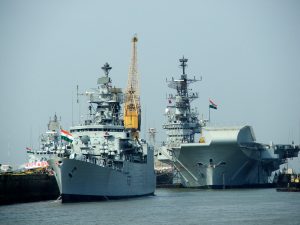The navies of India and Russia are taking part in a bilateral exercise on September 4 and 5 in the strategically vital Bay of Bengal. As the 11th edition of the exercise INDRA NAVY, which has taken place every two years since 2003, the two navies will “further consolidate interoperability” and “enhance understanding and procedures for multi-faceted maritime operations,” according to an Indian Navy statement. It goes on to add that while India will field a guided missile destroyer, an indigenous frigate, and a fleet tanker along with supporting helicopters, the Russian navy is sending two destroyers – Admiral Vinogradov and Admiral Tributs – as well as a tanker from its Pacific fleet.
The bilateral exercise takes place amid a flurry of activities between Moscow and New Delhi around the Shanghai Cooperation Organization. Indian Defense Minister Rajnath Singh is currently visiting Moscow for an SCO defense ministers’ meeting. Indian Foreign Minister Subrahmanyam Jaishankar is expected to visit the Russian capital for a meeting with his SCO counterparts next week. According to reports, while Singh is in Moscow, he is expected to hold a meeting with Wei Fenghi, the Chinese defense minister.
India and China are in the middle of their worst military crisis in almost 60 years, since the two countries fought a war in 1962. While China’s presence in the Russia-organized multilateral Kavkaz 2020 exercise — to be held between September 15 to 26 in Astrakhan in southern Russia — was one of the reasons why India had decided to sit it out, the bilateral INDRA exercise presents no such impediment. The location of the exercise, near the Andaman and Nicobar Islands, carries political import. As India and China face off in the high Himalayas in eastern Ladakh, the Indian Navy remains forward deployed in the Indian Ocean. The Islands – due to their proximity to the Malacca Strait chokepoint — are expected to be a crucial part of Indian naval strategy in event of war with China.
India and Russia maintain strong political-military relations that go beyond big-ticket arms sales. (I recently discussed the geopolitical imperatives that shape the India-Russia military trade relationship here.) Over the past couple of years, India has keenly courted Russia to adopt the Indo-Pacific construct. During a visit to Vladivostok in Russia’s Far East last September, Indian Prime Minister Narendra Modi proposed a maritime connection between that port city and the Indian city of Chennai, on the country’s southeastern coast.
Strikingly, sources told the Print in July this year that “India believes in order to address the challenges in a post-Covid world as countries are increasingly aligning with each other, it is ‘critically important’ that Moscow joins the Indo-Pacific framework and make it a true grouping of ‘like-minded countries’ that believe in freedom of navigation under a rule-based order.”
In July the U.S and India carried joint exercises in the Indian Ocean, with the U.S. Navy represented by an aircraft carrier strike group around USS Nimitz. Many in the past have questioned the signal India seeks to send China by simultaneously exercising with Russia, a key Chinese partner, as well as the United States given that the 2019 American Defense Department’s Indo-Pacific Strategy Report considered Russia a key threat to the Indo-Pacific.

































